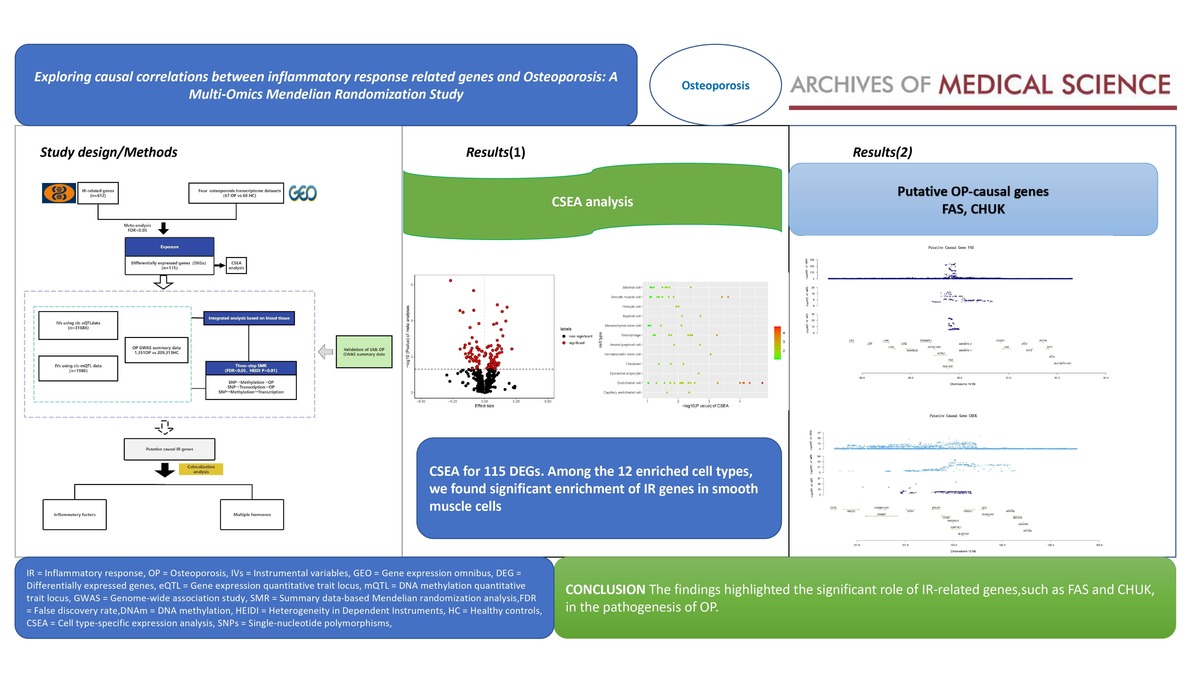Current issue
Archive
Manuscripts accepted
About the Journal
Editorial office
Editorial board
Section Editors
Abstracting and indexing
Subscription
Contact
Ethical standards and procedures
Most read articles
Instructions for authors
Article Processing Charge (APC)
Regulations of paying article processing charge (APC)
OSTEOPOROSIS / RESEARCH PAPER
Exploring causal correlations between inflammatory response related genes and Osteoporosis: A Multi-Omics Mendelian Randomization Study
1
Affiliated Hospital of Shandong University of Traditional Chinese Medicine, China
Submission date: 2024-10-30
Final revision date: 2025-05-13
Acceptance date: 2025-05-17
Online publication date: 2025-06-25
Corresponding author
KEYWORDS
TOPICS
ABSTRACT
Introduction:
The relationship between inflammatory response and osteoporosis has been the subject of extensive research; yet, their genetic link remains unclear. This study utilized IR-related genes as instrumental variables to represent IR, while summary data of OP served as the outcome to explore their genetic relationship.
Material and methods:
IR-related genes were retrieved from the GeneCards database. OP transcriptome datasets were collected from the Gene Expression Omnibus database and meta-analyzed to identify differentially expressed genes related to IR in OP. Genetic proxy instruments for IR-related genes were derived from studies of corresponding gene expressionand DNA methylation quantitative trait loci, respectively. Aggregated data for OP were extracted from the largest genome-wide association study of OP. We integrated QTL data with OP GWAS data to estimate their genetic associations using summary data-based Mendelian randomization analysis. Additionally, Bayesian colocalization analysis was employed to reveal the potential relationships between IR gene expression and inflammatory factors, as well as various hormones. Finally, to further validate whether the statistical evidence provided in GWAS were true-positive findings, a replication study was conducted here through genotype-phenotype associations.
Results:
Through SMR analysis, we found that the expression levels of two IR-related genes were associated with OP risk. Specifically, elevated gene expression levels of FAS increased the risk of OP. Conversely, increased expression levels of CHUK decreased the risk of OP.
Conclusions:
In summary, this multi-omics integration study reveals a genetic link between IR and OP, as represented by IR-related genes, and provides new insights into the potential pathogenic mechanisms of OP.
The relationship between inflammatory response and osteoporosis has been the subject of extensive research; yet, their genetic link remains unclear. This study utilized IR-related genes as instrumental variables to represent IR, while summary data of OP served as the outcome to explore their genetic relationship.
Material and methods:
IR-related genes were retrieved from the GeneCards database. OP transcriptome datasets were collected from the Gene Expression Omnibus database and meta-analyzed to identify differentially expressed genes related to IR in OP. Genetic proxy instruments for IR-related genes were derived from studies of corresponding gene expressionand DNA methylation quantitative trait loci, respectively. Aggregated data for OP were extracted from the largest genome-wide association study of OP. We integrated QTL data with OP GWAS data to estimate their genetic associations using summary data-based Mendelian randomization analysis. Additionally, Bayesian colocalization analysis was employed to reveal the potential relationships between IR gene expression and inflammatory factors, as well as various hormones. Finally, to further validate whether the statistical evidence provided in GWAS were true-positive findings, a replication study was conducted here through genotype-phenotype associations.
Results:
Through SMR analysis, we found that the expression levels of two IR-related genes were associated with OP risk. Specifically, elevated gene expression levels of FAS increased the risk of OP. Conversely, increased expression levels of CHUK decreased the risk of OP.
Conclusions:
In summary, this multi-omics integration study reveals a genetic link between IR and OP, as represented by IR-related genes, and provides new insights into the potential pathogenic mechanisms of OP.
Share
RELATED ARTICLE
We process personal data collected when visiting the website. The function of obtaining information about users and their behavior is carried out by voluntarily entered information in forms and saving cookies in end devices. Data, including cookies, are used to provide services, improve the user experience and to analyze the traffic in accordance with the Privacy policy. Data are also collected and processed by Google Analytics tool (more).
You can change cookies settings in your browser. Restricted use of cookies in the browser configuration may affect some functionalities of the website.
You can change cookies settings in your browser. Restricted use of cookies in the browser configuration may affect some functionalities of the website.



